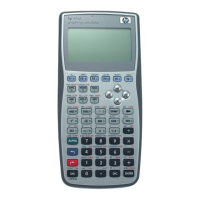Full Command and Function Reference 3-113
OBJ→
Type: Command
Description: Object to Stack Command: Separates an object into its components. For some object types, the
number of components is returned as item n+1 (stack level 1).
If the argument is a complex number, list, array, or string, OBJ
→ provides the same functions as
C
→R, LIST→, ARRY→, and STR→, respectively. For lists, OBJ→ also returns the number of
list elements. If the argument is an array, OBJ
→ also returns the dimensions { m n } of the array,
where m is the number of rows and n is the number of columns.
For algebraic objects, OBJ
→ returns the arguments of the top-level (least-nested) function (arg
1
… arg
n
), the number of arguments of the top-level function (n), and the name of the top-level
function (function).
If the argument is a string, the object sequence defined by the string is executed.
Access: !°
TYPE OBJ→ ( °is the left-shift of the Nkey).
!°
LIST OBJ→ ( °is the left-shift of the Nkey).
…&NL
OBJ→
!°L
CHARS LOBJ→ ( °is the left-shift of the Nkey).
Input/Output:
Level 1/Argument 1
Level
n+1
/Item
1
Level
2
/Item
n
Level
1
/Item
n+1
(x, y)
→
→
x y
{ obj
1
, ... ,obj
n
}
→
obj
1
→
obj
n
n
[ x
1
, ... ,x
n
]
→
x
1
→
x
n
{ n }
[[ x
1 1
, ... ,x
m n
]]
→
x
1
1
→
x
m n
{ m, n }
“obj”
→
→
evaluated object
'symb'
→
arg
1
... arg
n
→
n 'function'
x_unit
→
→
x 1_unit
:tag:obj
→
→
obj “tag”
See also: ARRY→, C→R, DTAG, EQ→, LIST→, R→C, STR→, →TAG
OCT
Type: Command
Description: Octal Mode Command: Selects octal base for binary integer operations.
(The default base is decimal.) Binary integers require the prefix #. Binary integers entered and
returned in octal base automatically show the suffix o. If the current base is not octal, enter an
octal number by ending it with o. It will be displayed in the current base when entered. The
current base does not affect the internal representation of binary integers as unsigned binary
numbers.
Access: …ã
OCT (ã is the right-shift of the 3key).
Flags: Binary Integer Wordsize (-5 through -10), Binary Integer Base (-11, -12)
Input/Output: None
See also: BIN, DEC, HEX, RCWS, STWS
OFF
Type: Command
Description: Off Command: Turns off the calculator.
When executed from a program, that program will resume execution when the calculator is
turned on. This provides a programmable “autostart.”
( i.e., a programmable …ç).
Access: „°LL
RUNL OFF ( °is the left-shift of the Nkey).

